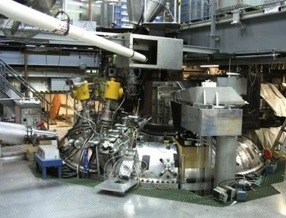Hydrogen beam injector guides plasma physics research
The Madison Symmetric Torus, a leading piece of equipment in plasma physics research for more than 20 years, recently gained a new capability with the installation of a neutral beam injector.
The addition allows University of Wisconsin–Madison researchers to delve further into the basic properties of plasmas — hot gases of charged particles — which are important in astrophysics research as well as numerous more down-to-Earth applications such as microchip fabrication, plasma TVs and other displays, and development of fusion technology.

The Madison Symmetric Torus gained new capabilities with the installation of a neutral beam injector.
A new study published online this week in Physical Review Letters reports the first description of the effects of instabilities generated by injecting hot plasmas with beams of uncharged particles — generally hydrogen — in a type of plasma confinement device known as a reversed field pinch, or RFP.
The nature of those instabilities can help researchers understand how the beam particles interact with the plasma and their potential beneficial uses, says UW–Madison graduate student Jonathan Koliner, who led the study with UW physics professors Cary Forest and John Sarff. Paper co-authors include other colleagues at UW–Madison, the University of California at Los Angeles, and Oak Ridge National Laboratory.
Neutral beams have sometimes been used to heat plasmas and drive electric currents in another type of plasma device, called a tokamak. Other times, the effects are more problematic.
“Like throwing rocks into a pond generates ripples, these particles come in and generate ripples [in the plasma]. Those ripples can feed back on themselves and start to grow very big, and when the ripples get big enough they’ll kick the particles out,” says Koliner.
More work is needed to understand and, ultimately, control the bursts to harness the particles’ energy rather than losing them from the plasma, he says. In addition, RFPs offer some advantages over tokamaks in studying basic plasma properties due to the way they contain and control plasmas. The beam on the Madison Symmetric Torus is the first on an RFP device and offers the first opportunity to characterize beam-generated instabilities in this type of plasma environment and compare them to those in tokamaks.
“Seeing what neutral beams can do in an RFP is a good way to figure out if you can use them to control [the plasma] in other ways in the future,” Koliner says. “It’s important first to lock down exactly what they do in all of the different possible plasma equilibria we can make in our machine. Once you figure out what they do, then you can come up with a plan.”
Koliner and his colleagues are studying the particle bursts under several plasma conditions and operating modes to form the best possible picture of what the plasma looks like and how it is behaving in the different situations.
“The bursts themselves have illuminated a lot of what the beam is doing that has been somewhat mysterious, not perfectly understood up to this point,” he says. “Knowing what these bursts do fills in a large piece of the picture.”




